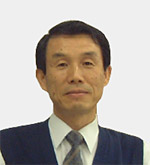 |
Dr. Seiji Shinkai
Professor,Sojo University
Professor Emeritus,Kyushu University
|
|
When grasping phenomena in my casual life, I cannot adapt myself to such a
way to grasp them from a frontal side straightly. I like to watch
them from various different angles and to find out the essence
which is invisible from the frontal angle. When I admire pictures
and sculptures in Italy, I have never been satisfied with such
a simple way to verify the presence of pictures and sculptures
which I once saw in textbooks. By observing them from various
angles, I try to understand intention of producers in my own
manner.
In general, the substance can be classified into three
phases, i.e., the vapor phase, the liquid phase, and the solid
phase: among them, the solid phase is more suitable for the design
of functional materials. In order to achieve the “innovation”
which has been raised as one of recent strategic research targets,
it becomes necessary to “solidify” gas and liquid. One can consider
that the interface can play an important role in this solidification
process. The goal of this Research Area is to gain cross-boundary
knowledge of nano-interface functions through the combination
of research fields that address interfaces between heterogeneous
materials and substances in different state at the nanoscale
level. Based on such knowledge, the studies will also be intended
to develop innovative materials, devices and technologies with
dramatically advanced functions through theoretical analyses
and nanoscale structural control. However, when the keyword “nano-interface”
is defined in a narrow sense, this strategic research sector
would not make constructive expansion from the starting point.
I rather consider that to define it in a broad sense would lead
to more productive and creative issues.
The first point is not
to limit the image of “nano-interface” to the morphology bearing
two-dimensional configuration from a macroscopic viewpoint. Namely,
this strategic research sector would not limit to a macroscopic
two-dimensional boundary but accept “nano-interfaces” created
by zero-dimensional (nano-particles, vesicles, cell surfaces,
etc.), one-dimensional (nano-tubes, molecule-assembled nano-fibers,
etc.), and three-dimensional (nano-pore crystal, etc.) superstructures,
which would, in a higher probability, lead to unexpected findings
and serendipitic breakthroughs. The second point is related to
the material to be used: in addition to hard materials such as
metals and particles, soft materials such as polymers, molecular
assemblies, gels, bio-originated products, etc. can be utilized
as resources to construct the novel “nano-interfaces”. I also
expect that the “nano-interfaces” provided by organic-inorganic
hybrid materials have a big future potential and that someone
may design a novel “nano-interface” showing a “fluctuation” phenomenon.
Lastly, I am not a retired researcher who can regard things
philosophically, but still a university professor who is actively
serving for research and student education. I therefore hope
to observe things with the same glance level as the CREST researchers
and discuss things with the same brain circuit. This is my philosophy
to lead the CREST researchers who join this strategic research
sector
|
